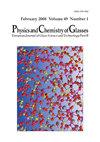掺锡铝酸镁玻璃的光学和辐射致发光性能
IF 0.3
4区 材料科学
Q4 CHEMISTRY, PHYSICAL
Physics and Chemistry of Glasses-European Journal of Glass Science and Technology Part B
Pub Date : 2019-02-14
DOI:10.13036/17533562.60.1.029
引用次数: 2
摘要
用于辐射探测的发光材料主要分为两类:一种是将电离辐射立即转化为数千个可见光子的闪烁体,另一种是积累辐射吸收能量的剂量计。在剂量计材料中,吸收的能量通过外部光(光激发发光,OSL)或热(热激发发光,TSL)的刺激释放出来,并作为发光读出,其强度与材料中沉积的能量成正比。因此,它们被用于个人剂量监测[1]。在本研究中,我们主要研究碱土硼酸盐玻璃,因为它们具有很高的TSL性能[2,3]。研究了熔体淬火法制备的不同Sn掺杂30MgO-50B2O3-20Al2O3玻璃的基本光学性能和辐射致发光性能。掺锡玻璃的光致发光光谱如图1所示。在300-600 nm处观察到一个宽峰,这是由于Sn2+的T1-S0弛豫所致。图2显示了PL衰减时间曲线,衰减曲线由单指数函数近似表示。衰变时间常数约为4.5 μs,是Sn2+的典型值。图1所示。样品在280 nm激发下的PL光谱。图2。样品的PL衰减时间曲线。在280 nm激发下,监测波长为400 nm。[1]李志强,刘志强。中国农业科学,2011,32(1)。[2]张建军,刘建军。中国科学:地球科学,2003(2)。[3]杨志强,杨志刚。j:。理论物理。, 53,05 fk05(2014)。Daisuke Nakauchi, 2015年毕业于日本大阪大学工程科学学院化学科学与工程系,获工学学士学位。他目前在日本奈良科学技术研究所(NAIST)材料科学研究生院攻读博士学位一年级,专门从事电离辐射探测器发光材料的开发。300 400 500 600 700 N或m .在城市里。u .]波长[nm] Ex.280 nm 0.01% Sn 0.1% Sn 1% Sn 0 5 10 15u)波长(nm) 1% Sn我= I0 + I1exp (Sn - t / 4.5μs) 0.1%我= I0 + I1exp (Sn - t / 4.6μs) 0.01%我= I0 + I1exp (- t / 4.5μs) Ex.280 nm / Em。400海里本文章由计算机程序翻译,如有差异,请以英文原文为准。
Optical and radiation-induced luminescence properties of Sn-doped magnesium aluminoborate glasses
Luminescent materials for radiation detections are mainly classified as two types: scintillators which convert ionizing radiation to thousands of visible photons immediately and dosimeters which accumulate the absorbed energy of radiation. In dosimeter materials, the absorbed energy is released by external stimulation of light (optically stimulated luminescence, OSL) or heat (thermally stimulated luminescence, TSL), and read out as luminescence whose intensity is proportional to the deposited energy in the material. So, they are utilized in personal dose monitoring [1]. In this study, we focused on the alkaline-earth borate glasses because of the high TSL properties of them [2,3]. We evaluated the basic optical and radiation induced luminescence properties of Sn-doped 30MgO-50B2O3-20Al2O3 glasses with various Sn concentrations synthesized by the melt quenching method. The photoluminescence (PL) spectra of the Sn-doped glasses are represented in Figure 1. A broad peak around 300-600 nm is observed, which is attributed to the T1-S0 relaxation of Sn2+. Figure 2 shows the PL decay time profiles, and the decay curves are approximated by the single exponential function. The decay time constants are about 4.5 μs, which are typical values of Sn2+. Figure 1. PL spectra of the samples under excitation at 280 nm. Figure 2. PL decay time profiles of the samples. Monitored wavelength is 400 nm under excitation at 280 nm. References [1] S.W.S. McKeever, Rad. Meas. 46, 1336 (2011). [2] Sangeeta and Subhash C. Sabharwal, J. Lumin. 104, 267 (2003). [3] Y. Fujimoto, T. Yanagida, Y. Futami and H. Masai, Jpn. J. Appl. Phys., 53, 05FK05 (2014). Brief Biographical Notes Daisuke Nakauchi received B.Eng. degree from Department of Chemical Science and Engineering, Faculty of Engineering Science, Osaka University, Japan in 2015. He is currently in the first year of Ph.D. program at the Graduate School of Materials Science, Nara Institute of Science and Technology (NAIST), Nara, Japan, specializing development of luminescent materials for ionizing radiation detectors. 300 400 500 600 700 N or m al iz ed In te ns ity [a . u .] Wavelength [nm] Ex.280 nm 0.01% Sn 0.1% Sn 1% Sn 0 5 10 15 In te ns ity [a . u .] Wavelength [nm] 1% Sn I=I0+I1exp(-t/4.5μs) 0.1% Sn I=I0+I1exp(-t/4.6μs) 0.01% Sn I=I0+I1exp(-t/4.5μs) Ex.280 nm/Em.400 nm
求助全文
通过发布文献求助,成功后即可免费获取论文全文。
去求助
来源期刊

CiteScore
0.70
自引率
33.30%
发文量
0
审稿时长
1 months
期刊介绍:
Physics and Chemistry of Glasses accepts papers of a more purely scientific interest concerned with glasses and their structure or properties. Thus the subject of a paper will normally determine the journal in which it will be published.
 求助内容:
求助内容: 应助结果提醒方式:
应助结果提醒方式:


